
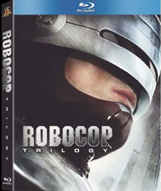 BUY FROM AMAZON: CLICK HERE!
BUY FROM AMAZON: CLICK HERE!
STUDIO: 20th Century Fox
MSRP: $59.99
RATED: R, R, PG-13
RUNNING TIME: 325 minutes total
SPECIAL FEATURES:
• Just the original movie trailers. Seriously, this thing is bare-bones.
The Pitch
A robot cop. In Detroit.
The Humans
Starring Peter Weller, Ronny Cox, Robert John Burke, Miguel Ferrer, Kurtwood Smith, CCH Pounder
Written by Edward Neumeier, Michael Miner, Frank Miller, Walon Green, Fred Dekker
Directed by Paul Verhoeven, Irvin Kershner, Fred Dekker
The Nutshell
When Alex Murphy (Weller), a cocky young Detroit cop, gets gunned down by thugs, he becomes the ideal candidate for OCP’s RoboCop program. He’s given a new life as a cyborg law enforcement officer where he finds that his past life hasn’t quite left him entirely. Battling those who killed him before, as well as his own corrupt owners, RoboCop also finds that he’s actually more human than machine. Two more installments involve Murphy still dealing with OCP corruption and escalating Detroit violence in more campy ways.
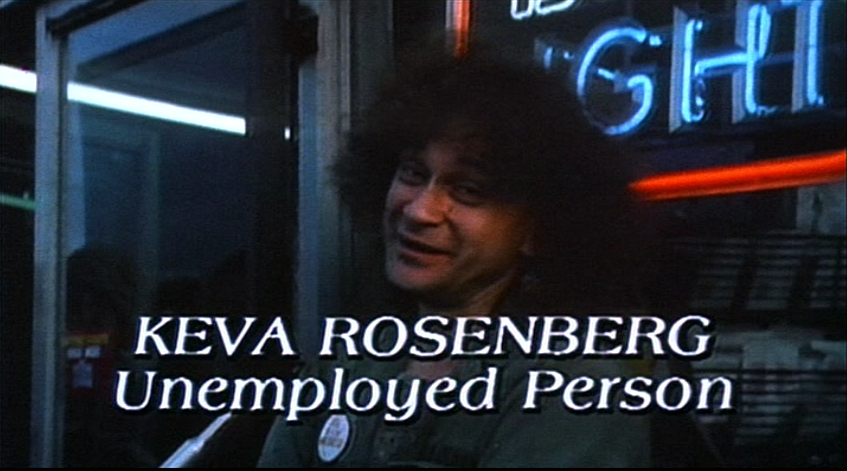
Twenty years later, Keva’s still in Detroit and still an unemployed person.
The Lowdowns
RoboCop
Undoubtedly the best entry in the RoboCop canon, the original is also one of the best films of the 1980s. A satirical, layered sci-fi film that creates a fully formed world barely different from our own and populates it with memorable characters that still pack a punch over twenty years later.
And much of that credit goes to director Paul Verhoeven. Compared to the other two RoboCops, Verhoeven’s film showcases his confidence through a much more assured camera than anything the others could muster. Rather than blocking every scene off with a master and shot-reverse-shot construction, Verhoeven frequently went hand-held and mobile, giving his compositions more life and energy. Those frames were aided by tight editing in post, producing a brisk pace that moves the story along with no down time, no opportunities missed, no unnecessary scenes.
That’s also helped by the taut script, which gives us info and exposition brilliantly through action rather than boring scenes of plot buttressed by hollow action sequences. It’s amazing what happens when you put the two together. The screenplay also does something that the successors couldn’t do: conjure up good characters. From Emil to Clarence Boddicker, and Dick Jones to Johnson (wow, there sure are a lot of phallic names in this one, aren’t there?), these characters get depth, some dimension, that none of the subsequent films managed to achieve. All of that gives the whole subversive plot about corporate corruption more texture and grounding in reality, something that the last film didn’t even bother to attempt to create.
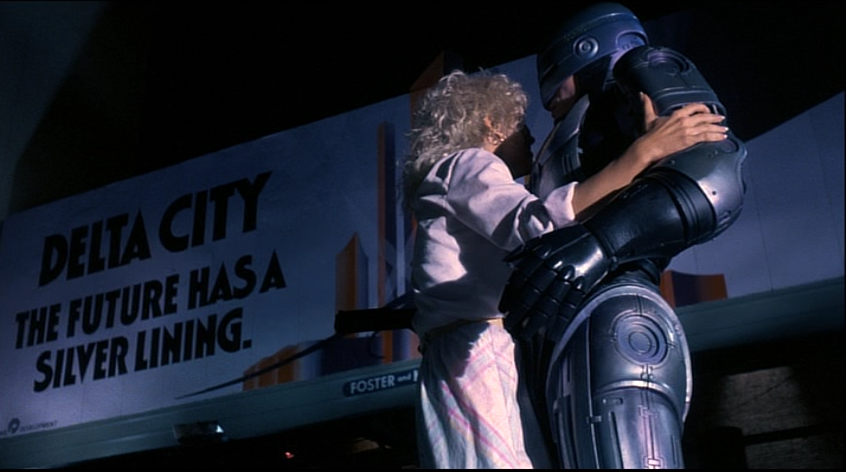
“I’ll show you something with a silver lining.”
With those well-written parts, the actors who embodied them took them to the next level, especially Peter Weller, without whom the movie could’ve played out like a cheesy parody of superhero movies. Instead, the film’s core story about what makes us human shines because of how believably Weller portrays both a young, cocky police officer and a human-like robot. It’s a physical tour-de-force – from how he establishes Murphy’s human qualities by learning how to spin a gun and smirk to his robotic movements when he’s RoboCop, and how he brings them all together in the end.
All of those individual elements of the film work because once the world is established, things stick to the rules. There aren’t those moments where logic gets thrown away just so the plot can continue — something I can’t say for the other two movies. While there’s a moment where RoboCop has the chance to kill Boddicker but doesn’t because one of his established directives was to uphold the law, hence he can’t kill him. It keeps the movie going because of the storyline, not in spite of it.
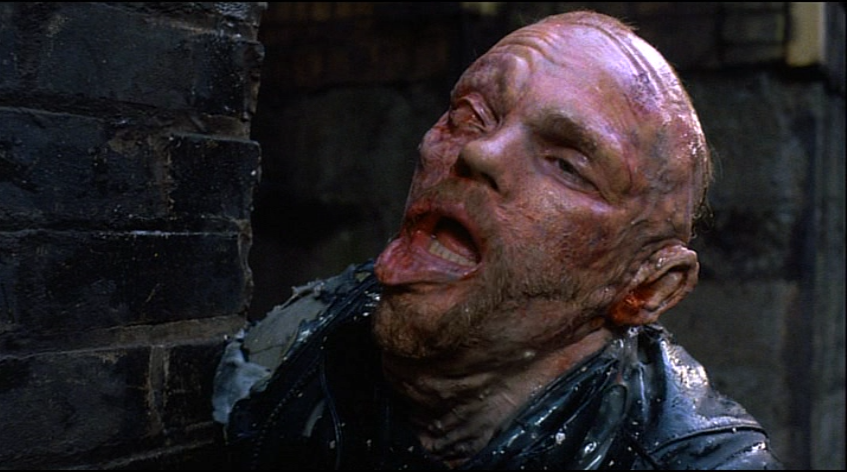
In the future, herpes is not the way you want to go out.
Part of that established universe is that, aside from ED 209 and the fact that they can even make a RoboCop, this isn’t the future. There aren’t any special new gadgets, no flying cars or laser guns. In fact, to show just how much this is the here and now, the only laser guns are on the TV show that Murphy tries to emulate. This is still 1987, and the only conceit that you have to swallow is that our current technology allows for Robos to be created.
Another conceit of the film is that Robo is vulnerable. At first it seems like he’s indestructible when he goes on a crime-ending spree, saving a woman from two would-be rapists and ending a standoff between an ousted mayor and his hostages – among other noble deeds. Bullets ricochet off his body armor. His aim is perfect. But he’s not immortal. After Dick Jones calls out an execution hit on him, the entire police force opens fire as he escapes from the station in a scene mirroring the one in the first act where Murphy is originally killed. Only this time is survives, albeit damaged – his aim is off, his mask cracked.
As Robo starts to come to his senses, he’s less of a machine and more of a man in a robot suit. He spends the last act of the film with his mask off, leaving his full face unsheathed. Which brings us to that ultimate moment at the end, when after he’s killed Boddicker and Dick Jones, and destroyed ED 209, the OCP head honcho asks him his name, to which he responds: “Murphy.” Even after numerous viewings, it’s still so satisfying.
Truly a masterpiece.
Rating: 




Out of a Possible 5 Stars
RoboCop 2
The same can’t be said for the sequel.
RoboCop 2 seems more like a remake than a bona fide sequel. Like this is some parallel universe where screenwriter Frank Miller read the first act of RoboCop and then wrote his own version of what happens after. From the get-to, Robo is still dealing with whether or not he’s a person or a machine.
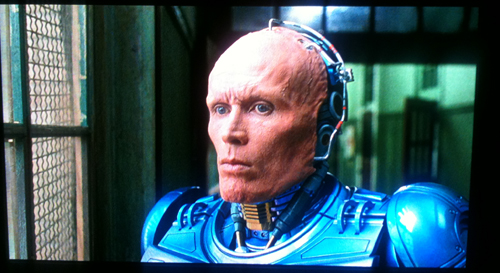
An introspective moment with Alex “RoboCop” Murphy as Peter Weller wonders why in the hell he agreed to the sequel.
I suppose we can assume that, since everything in Detroit is even worse than before with OCP still corrupt and more powerful – with The Old Man and Johnson still at the helm – Robo was reset after the whole first episode. It’s just such a lazy concept, though, to retread the same territory that the first one did so brilliantly. The only chance that the sequel could’ve been successful would’ve been had they tackled different themes, or at least come at them in a different way by expounding on them. Not by just doing it all over again.
This is like the comic book version. Dystopic Detroit is depicted as being way over-the-top with cops on strike, crime and violence through the roof and a new designer drug called Nuke is everywhere. It’s seriously bad enough that, were this reality, the National Guard would’ve been called in a long time ago. Where the first movie felt like it could’ve been happening in our current place and time, this one doesn’t. The characters have become caricatures. Verhoeven’s brilliance at riding that fine line between parody and satire is even more evident watching this installment, which treats the frequent media breaks of social commentary-filled “commercials” as being just part of the whole RoboCop structure, missing the entire tone and purpose of those segments to create the world. They end up being just filler here to try to convince us that we’re watching a RoboCop movie, but failing to make us feel anything.
There are also many structural problems with the film. The only reason we consider Robo the hero is because we know we should since we remember him from the first movie. We felt for him then and went along with him on his existential struggle. But, in this movie his humanity is gone and as he goes through the same flashbacks of his life as Murphy, we can’t help but feel like we’ve already see this movie, only done far better. And then RoboCop essentially disappears for a large part of the second act.
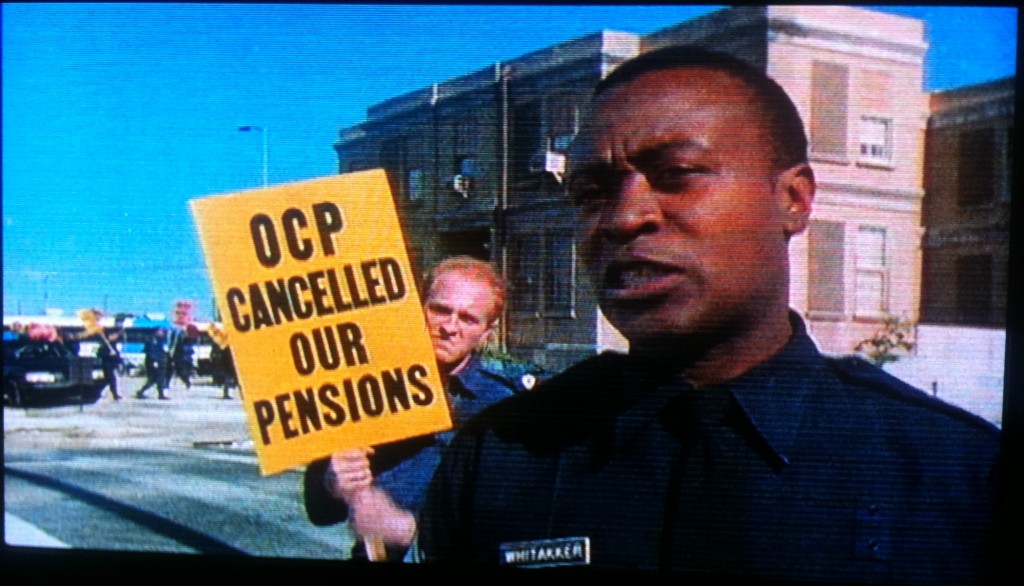
And Republicans rejoice.
The new bad guy, another bald, white crime lord named Cain (who’s not nearly as charismatic and dementedly likeable as Boddicker) chops Robo into bits about halfway into the movie. Instead of actually destroying him, he just lops off his arms, legs, and at the waist, leaving his head intact and drops him off at police headquarters where he literally hangs there while the scientists argue that RoboCop is in agony and the OCP henchmen say he’s just a machine and demand that his memory get wiped. In the first movie, the moral question of whether or not Robo should be treated as a human being or a machine was played out through RoboCop; in this one, random characters we barely know debate this in front of him and we’re supposed to be engaged all the same. As you can imagine, this is where the movie lags hard.
With Robo out of commission, we have no real throughline to feel connected to. We follow Cain and his juvenile understudy Hob as they continue to take over Detroit by turning everyone into Nuke junkies. And then there’s the OCP doctor who wants to scrap RoboCop in favor of her concept for the next generation of robocops – hence, RoboCop 2. It wouldn’t be a sequel without another actual RoboCop. It’s a mish-mash of ideas that never gels properly due to the poor execution of the script. If you’re going to take out the lead from a bunch of scenes in the middle of your movie, you’d better have a good reason and something good to make up for it. Miller and Co. don’t.
And when once Robo gets reassembled and comes back to keep the movie going, he’s essentially this peace-loving hippie; the worst cop ever. Instead of fighting crime, he tries to just tell kids to be better as they’re looting a store. Clearly that doesn’t work. But instead of using this new plot turn to add to the conflict, moments later he’s back to normal. It’s like a group of people sat around talking about what would be funny or cool and just tossed it into a script salad and out came this mess. Like it’s some other flick with a little RoboCop sprinkled in.
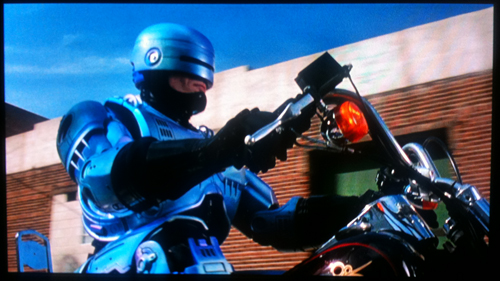
“T-800, eat your heart out.”
While the original movie provided social commentary about how corporate executives are more ruthless and emotionless than a synthetic humanoid (apt for the Reagan Era), this movie shows almost all of humanity as being pure evil – psychotic sadists whose only pleasure comes from hurting others with zero interest in the human condition. At least Dick Jones, Bob Morton, and Clarence Boddicker had human qualities – clearly mainly our most negative ones, but human nonetheless. The people in RoboCop 2 tend to be more like sharks – soulless and just absurdly, unnecessarily violent. Everyone in this one is just out for themselves on the grand scale (perhaps a dig on objectivism?). And it just all fails miserably because there’s no foil.
Another big downfall – and again, this comes down to the shoddy script – is that it doesn’t adhere to its own rules, instead totally throwing them out the window when it doesn’t help the plot. For instance, in one scene it goes out of its way to show that Robo can shoot a perp without even looking, yet when Cain is driving straight at him, in plain sight, he can’t come close to hitting him. The type of thing that the first Robo managed to avoid and this one could’ve too; if only the screenwriters hadn’t been so lazy.
And then over an hour into the movie, it gets totally cartoonish. We’re talking Teenage Mutant Ninja Turtles-style cartoonish – the 90s TV show, not the movies. The OCP doctor who has her own ideas for a RoboCop 2 program volunteers Cain and uses him to embody the next gen law enforcement android – but before they can transplant him into his metal skin, they show the full-on surgery where the doctors remove his skull cap and manage to remove his entire nervous system, keeping it all intact in a jar like Krang from TMNT. And then once he gets into his machine body, instead of keeping his face showing, a screen appears to show a Lawnmower Man-esque CG face. It’s just plain absurd. And it shows that early-stage computer graphics ages about as well as a discount bottle of Charles Shaw while practical effects feel both dated and timeless at the same time.
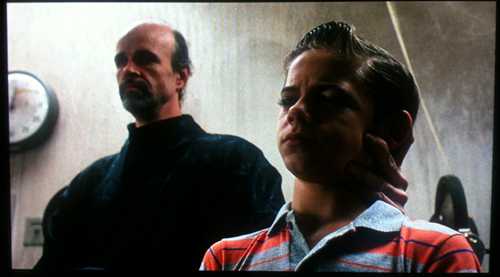
Look, kid, if we have to watch this cinematic abortion, so do you.
Somehow, the end actually is relatively satisfying in an emotionally divorced, I’ve-already-given-up-on-this-movie kind of way. The final showdown between Robo and Cain.0 is fine, as far as machines fighting go – something that would be done infinitely better in T2 a year later. (Another T2 similiarity – Robo on a motorcycle while Cain drives a semi-truck, although infinitely less exciting than Cameron’s version.)
In the end, RoboCop 2 tries to do too much, with the influence of too many cooks in the kitchen sealing this one’s fate. If you want to save yourself two hours, just watch Trailer 2 off the Blu-ray and you’ll get basically the entire movie summed up for you in three minutes, which is the most you’d ever want to spend with this flick.
Rating: 




Out of a Possible 5 Stars
RoboCop 3
While we had lost the director and screenwriters from the first movie to the second, trading them in for Irvin Kershner, Frank Miller and Walon Green, there was still hope that it would be decent since Robo was still being portrayed by Peter Weller. Not anymore. Citing a scheduling conflict, Weller made the wise choice to instead film Naked Lunch.
Enter Robert John Burke, who did as well as he could given the laughable script by returning screenwriter Frank Miller and director Fred Dekker. That, along with being the only entry in the notoriously violent series being rated PG-13, guaranteed a shift in the franchise — no more hands exploding, bodies melting in toxic waste, or brain stems being stored in jars. Sad on so many levels; mainly that anyone bothered to make this movie. They make up for it though with way more indiscriminate killing, just sans blood — arguably even worse for the teenage crowd going to see the film now since it still has violence but without any sense of repercussions.
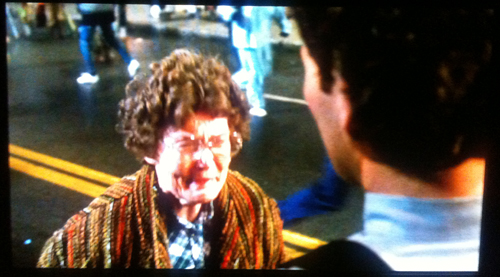
I feel your pain, lady.
Going even further into comic book territory – Miller injected elements from his own comics into the Robo-verse – Detroit is literally a total warzone and is completely owned by OCP now, who is going around like the Gestapo kicking people out of their homes and rounding the people who won’t leave into buses to take them away. Sticking to the odd structural decisions from RoboCop 2, a group of resistance fighters end up being more of the main characters than RoboCop – including this little girl who can hack into anything with a computer, including an ED 209. I almost expected her to say “easy money,” after she was done.
It’s clear from the opening scenes that we’re totally in the world of self-parody now, even if the filmmakers don’t quite realize it. Plus it’s clear that they have no interest in creating rules for this universe. RoboCop is used just as a prop, living up to his condensed name of being a robot cop, nothing more. Again the idea of his memory and past life and humanity get a few random moments that seem like they’re only there because someone thought they needed to be in order for it to truly be a RoboCop movie. No depth, no emotion, no point. Yet, for whatever reason, everyone now calls him Murphy. He’s the least human than he’s ever been all series (he actually has a gun for a hand in one scene!) and now is when everyone treats him just like he’s a normal dude? Murphy also can choose to ignore direct orders now. Even though OCP, which is even more controlling and evil than ever before, still owns him and treats him like a machine, they’ve decided to remove the fail-safes that prevent him from following orders? Makes zero sense.
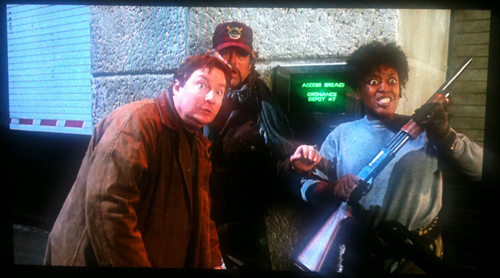
Yeah. It’s this bad.
And then there’s the plot: Rebels fight against OCP (headed up by Rip Torn!) who joins forces with a Japanese corporation to take over all of Detroit. After OCP kills Lewis (one of the lone holdovers from the previous movies) and shoots Murphy in the chest with a grenade, he goes underground with the rebels where he proceeds to shut down. The Lewis Death Scene is classic. Literally in the scene just before her demise, a fellow cop asks randomly, “Aren’t you going to put on your body armor?” to which she replies, “No, I’m off duty.” Permanently! A seven-year-old could see that coming.
And then shortly after that, again we have that confounding plot concept of taking the main character out of the movie for a large swath of the second act where the film follows this kid who is able to sneak into the police station and find Robo’s main scientist/doctor, the one person who can help save him. This choice is slightly less jarring in the third film since it’s become much more of a Frank Miller hodgepodge with RoboCop sprinkled in rather than a true RoboCop movie. It doesn’t make it any less bad, though.
Then it turns into almost a Western, with the cops and the rebels teaming up against OCP and the Splatterpunks (random anarchists that were introduced in the beginning just so that they could come back in the end), fighting out in a street in which you’d expect tumbleweeds to be passing through. Which wouldn’t necessarily be awful except that while all of this is going on outside, Murphy is down in a basement losing power and seriously stumbling around like a drunken, blacked-out frat boy. It’s never explained what’s wrong with him other than simply as an excuse for him to strap on a JETPACK (which is conveniently also an alternate power source that was oh-so-eloquently explained to us earlier). But before he remembers that, he has to battle a Japanese assassin who just so happens to be an advanced android, even more so than Murphy. Oh yeah, also, he’s a samurai. Yes, you heard that right: a cyborg samurai. I can’t even convey how dumb it all is. Or the fact that the fight ends up being so awkward since Robo isn’t exactly known for his agility and samurai swords don’t exactly provide good defense to guns. (In case you’re wondering: Robo wins.)
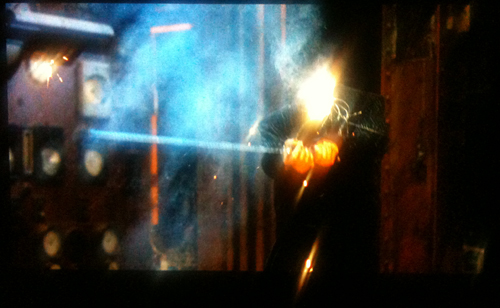
Gun > sword = America > Japan
But it’s not over yet.
After Murphy goes total superhero and takes out all of the bad guys by strafing them with his jetpack, he breaks into OCP to find that there are TWO MORE CYBORG SAMURAIS! Unfortunately, he’s completely neutralized by one single punch to the face and left to die. One punch. That’s it. Done. This is after he took a grenade to the chest and lived to tell about it. Luckily though the little girl from the beginning who hacked into the ED 209 hacks into the samurais magically (maybe she has wi-fi?) and gets them to kill each other. But it’s not over yet because these have self-destruct mechanisms that are tripped when they died, so Robo wakes up quickly enough to save the girl and the kid with his jetpack and soars them out of there just when the building explodes.
Just writing about all of this makes me feel dumber. I can’t imagine what anyone involved in the actual scripting and shooting of this film must’ve felt in the development stage. While the second movie turned the RoboCop ship away from sci-fi and more toward cartoon, this one just goes off the rails, entirely living in a ridiculous comic world with no rules, no logic, and no believability. Even if we leave the original classic out of the discussion and only look at entries 2 and 3, this final episode is just atrocious. A sad finale to the saga of Alex Murphy, and one that everyone should avoid at all costs.
Rating: 




Out of a Possible 5 Stars
The Package
With nothing in the way of extras, this is a bare-bones Blu-ray offering. The films themselves look as good as they individually can look, with their quality declining with each installment. The original looks solid in hi-def, but not even a crystal-clear image can make the other two easy on the eyes. If you’re a RoboCop completist, then this is for you simply because it offers all three movies in one package. Otherwise, I’d just go for the solo RoboCop Blu-ray.
Rating: 




Out of a Possible 5 Stars
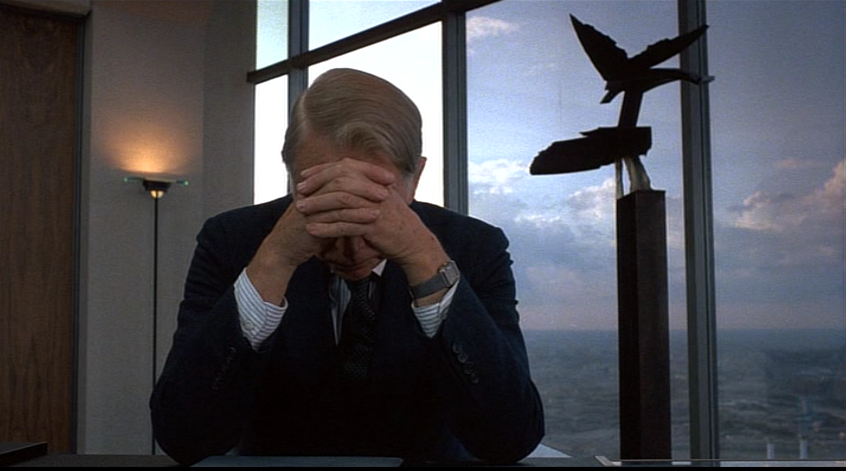
There, there, now. Didn’t you hear? The recession is over!
(Note: Screencaps not taken from Blu-ray.)